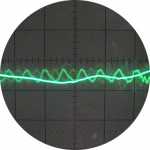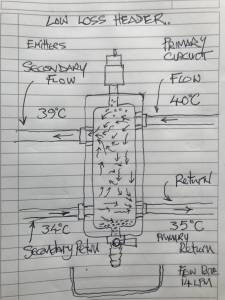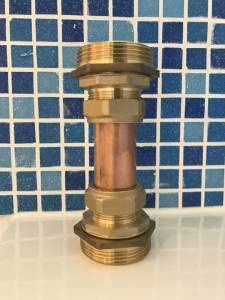Low Loss Header is losing 1.5c from flow temperature
@iancalderbank thanks Ian
yes there is a drop in flow temp across the LLH but there is a more or less equal rise in return temp across the LLH. These were tested with a separate thermistor…
I don’t know if there is a way of working out a quantifiable energy cost for the increased generated DT to create the desired DT at the emitters but perhaps it isn’t as big as I’m thinking it might be?
thanks for your insights on this
Posted by: @sunandair@iancalderbank thanks Ian
yes there is a drop in flow temp across the LLH but there is a more or less equal rise in return temp across the LLH.
doesn't matter. check the datasheet 2 posts up. the higher the flowT, the worse the COP. same for any heat pump.
also you are talking about loss of DT, but in your sketch, DT is the same both sides, which it would be if flow rate is the same. heatgeeks explanation is pretty good as they usually are https://www.heatgeek.com/low-loss-headers/
My octopus signup link https://share.octopus.energy/ebony-deer-230
210m2 house, Samsung 16kw Gen6 ASHP Self installed: Single circulation loop , PWM modulating pump.
My public ASHP stats: https://heatpumpmonitor.org/system/view?id=45
11.9kWp of PV
41kWh of Battery storage (3x Powerwall 2)
2x BEVs
Posted by: @iancalderbankDT is the same both sides,
hi Ian,
here is my sketch again what do you mean that the DT Is the same both sides? The sketch shows a 1degC drop in one direction and a 1degC rise in the other direction…. Is that what you mean?
the Heat Geek info looks interesting
Will look in due course… thanks
Posted by: @sunandair@iancalderbank thanks Ian
yes there is a drop in flow temp across the LLH but there is a more or less equal rise in return temp across the LLH. These were tested with a separate thermistor…
I don’t know if there is a way of working out a quantifiable energy cost for the increased generated DT to create the desired DT at the emitters but perhaps it isn’t as big as I’m thinking it might be?
thanks for your insights on this
Assuming I understand the question correctly (which I may not) then yes there is. Plot COP vs flow temperature, then work out the COP (at some representative OAT eg 7C) for the two 'alternative' flow temperatures required to achieve the same FT at the emitters (ie with and without the LLH, or more simpl the original design FT and that plus the reduction in FT across the LLH). Then use that to work out the change in energy consumption due to requiring a higher FT from the ASHP.
So for example with a Mitsubishi R32 11.2kW the COP at 7/40 is 4.55 and its 5.11 at 35/40. That translates to a 12% increase in consumption for a 5C rise in Flow temp, so about 4% for a 1.5C rise.
Here is a quick table for the 11.2kW Mitsi
This accounts only for the reduction in thermodynamic efficiency of the heat pump, not for any energy losses in the LLH (which, assuming its well insulated, should be negligible). It also assumes that the pump speeds (l/s) both sides of the LLH are approximately equal (if they aren't then youare forcing mixing which is a bad idea)
4kW peak of solar PV since 2011; EV and a 1930s house which has been partially renovated to improve its efficiency. 7kW Vaillant heat pump.
@jamespa perfect….
thanks James
Added
(We tried a number of secondary pump settings until we got the lowest change in DT but we couldn’t do much better than 1degC. At least we are dealing with constant flow rates…. )
Ive already built my secondary pump bypass….
DT is a phrase used too much in HP discussions, one needs to be clear about between what points the difference is being measured. Its normal that DT is used to refer to the difference between flowT and returnT. In your case, DT on the left side is 5C. (39-34). DT on the right side is also 5C (40-35). DT times flow rate gives you the heat energy transfer rate, which has to be the same each side - there is no input or output of energy in the LLH. If the flow rates are different on each side then DT would be different each side, but the energy transfer would still be (MUST BE) the same. The LLH isn't "losing" energy (it can't, its not an emitter - assuming its well insulated).
But what the LLH does, is force mixing to happen, which MUST reduce the flowT on the emitter side. this reduces the efficiency of the system as a whole, once you consider how the energy input device (the HP) works. To get an emitter temp of 39C, you have to run your HP at 40C. This costs you x% in HP efficiency - its guaranteed, for any HP, the higher the HP flowT, the less efficient it is. (as per jamespa, probably around 3% for 1C). If your drop in FlowT is worse, this % gets higher (= worse).
If you have a poorly balanced LLH - widely differing flowT's - then the drop in flowT would be worse, thus increasing the need to run the HP at an even higher temperature OR leading to too-cold emitters that don't warm the house - thus giving an even less efficient system with an even worse COP.
If you've already got it down to only a 1 degree drop in flowT across the LLH, by tweaking your secondary pump, thats pretty good - implies you've got it down the least amount of mixing that you can (whilst still keeping the LLH). the only way to get better will be to repipe without it. additional benefit of that is you only need 1 pump, and you can also potentially use a variable circulation speed (either a CP or PP pump , or a PWM pump controlled by the HP, or a DT-targeted pump), starting point for that discussion should be what is the pump within your ASHP capable of.
My octopus signup link https://share.octopus.energy/ebony-deer-230
210m2 house, Samsung 16kw Gen6 ASHP Self installed: Single circulation loop , PWM modulating pump.
My public ASHP stats: https://heatpumpmonitor.org/system/view?id=45
11.9kWp of PV
41kWh of Battery storage (3x Powerwall 2)
2x BEVs
- 26 Forums
- 2,378 Topics
- 53.9 K Posts
- 299 Online
- 6,060 Members
Join Us!
Worth Watching
Latest Posts
-

Here is an update of the setback we operate on our syst...
By SUNandAIR , 37 minutes ago
-
RE: Grant ASHP 17.5 kw. weather curve
@chinkoa Sorry there are two separate thoug...
By JamesPa , 1 hour ago
-
RE: Radiator sizing sanity check
Agree. I think I have given you several pointers to he...
By JamesPa , 1 hour ago
-
RE: Solar Power Output – Let’s Compare Generation Figures
@transparent As easy as putting sparklers in champag...
By Papahuhu , 1 hour ago
-
RE: Testing new controls/monitoring for Midea Clone ASHP
As somebody with 30 years professional experience in co...
By Mosibi , 4 hours ago
-
@f1p Looks good, and will likely be something I use whe...
By Sheriff Fatman , 4 hours ago
-
RE: Cascade 2x Grant Areona 10kw ASHP - Ongoing setup issues
Either complete Bow Locks or at best a marginal effect....
By JamesPa , 7 hours ago
-
Hi all I’m looking to get some insight on what others...
By Renewables345 , 7 hours ago
-

RE: The Great British Heat Pump Owner Persona Survey: Let's Build Our Archetype!
@mosibi, go on then, complete the survey. Let's get the...
By Mars , 8 hours ago
-
RE: Water Hammer After Heat Pump Install
@jaynieq I wish you luck with this one. I think the ma...
By JamesPa , 10 hours ago
-
RE: Optimum new build house design for Heat Pump
From first principles I would say: Definitel...
By JamesPa , 1 day ago
-

RE: Weather compensation- why you should use it
As good a place as any to drop this video:/p>
By Mars , 1 day ago
-
RE: Forum updates, announcements & issues
@transparent D'Oh - I did look before I posted but I mi...
By dr_dongle , 1 day ago
-
Compatibility with Samsung AE080RXYDEH
I am new to all this. We have a SamsungAE080RXYDEH that...
By John999 , 1 day ago
-
RE: New Fogstar 15.5kWh upright solution
@batpred Maybe you should buy your additional batter...
By Bash , 1 day ago
-

RE: Data Accuracy Problem: Daikin 8kW Heat Pump's Onecta App vs MMI Power Consumption
@nursethescreens Yes, comfort and happiness of the fami...
By Toodles , 1 day ago
-
RE: Connecting Growatt SPH5000 over wired ethernet rather than wireless
Thanks folks. I had tried googling an ethernet lab adap...
By z8lccda , 2 days ago
-
RE: Changing from 4-port buffer to volumizer
@toodles I'm not concerned that the behaviour is not no...
By Andy1618 , 2 days ago
-

-

RE: Setback savings - fact or fiction?
I agree, and I think there are two things in play here....
By cathodeRay , 2 days ago







